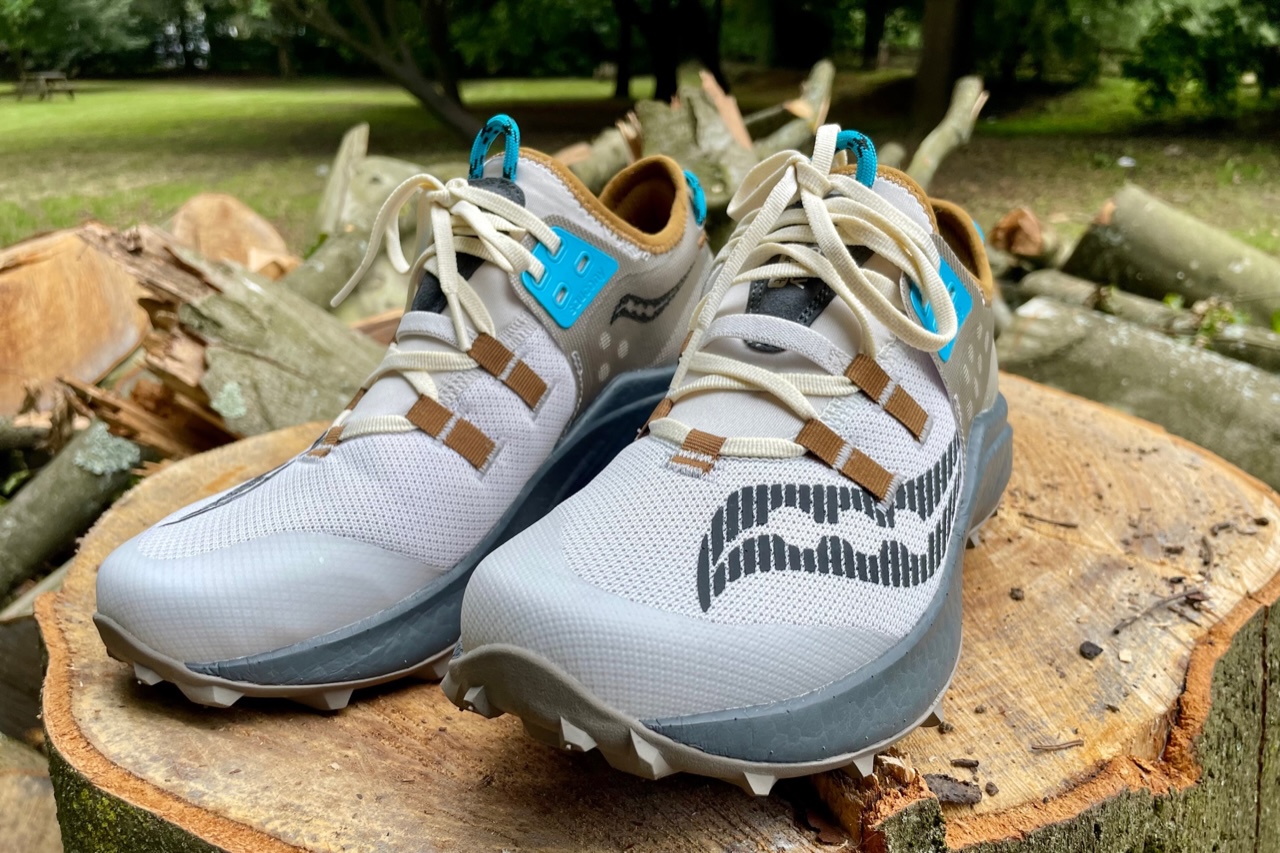The Endorphin Rift is the latest addition to Saucony’s trail range. Saucony have borrowed many of the premium features from their other models for the Endorphin Rift to create a versatile model, also noting these are not carbon plated but feel like an improvement over the similarly looking, carbon-plated, Endorphin Edge trail shoes.
I received the Endorphin Rift a few weeks before I was due to head to Chamonix to race UTMB. I included them right away in my training, which was (unfortunately for me) not in the Alps at altitude, but on my local English hills, with as much variety and technicality as I could find. I was immediately impressed by their performance, comfort, and versatility. It made me decide to use them for UTMB instead of another pair of another brand I had in mind, and that I had raced with before. Spoiler: I successfully finished the race in one piece, with no shoe change needed or wanted. UTMB was the ultimate test I could run for the Endorphin Rift, and they delivered.

Out of the box, these shoes look compact, with a streetwear feel from the plastic overlay around the heels and to the upper eyelets. The version I had was a pleasant white, brown and blue combination, the white settling to grey after many hours on dirty trails. I was surprised when I weighed them new on my kitchen scale. They were notably lighter (235g on a UK 7.5) than several other popular compact, racing trail shoes, and despite looking bulkier. This is mostly due to their simple design, and the ultralight, low density midsole foam – more about that below.
The outsole is made of PWRTRAC rubber with a sharp lug geometry. Combined with a 4.5mm lug height, the shoes provide superior grip and traction. I tested them first in England on dry, moderately wet, and muddy ground, on all kinds of gradients, on dirt and on rock.
During my training I notably climbed and ran down steep (i.e. over 30-degree gradient) dirt slopes. I felt like a fly sticking to a wall, unlike some other trail shoes I had tested on the same segment and that would have made me slide. The grip was similarly strong when running over mud. I continued testing them in the Alps during the race on tougher conditions, with much longer climbs and descents, and had the same experience. Overall, I felt confident and trusting the shoes to run down at speed, and climbing hills without slipping.
The midsole is made of PWRRUN PB foam, the same that can be found in Saucony’s road super shoes. This foam is noticeably light and bouncy. The stack is relatively high for trail shoes, at 33mm heel/27mm forefoot/6mm drop. Despite of this, and the shoe being on the narrow side, they were stable – noting the rock plate likely contributes to stability. They were well-cushioned without the marshmallow feel often found on super foam high stack shoes, and felt reactive, the additional bounce being a bonus. What sensation may be lost by being further away from the ground from the midsole stack was more than compensated by the comfortable ride needed to withstand long distances.
The foam stack and rock plate also protected the feet well from rocky and irregular ground. What surprised me was they felt like road shoes and fast when on tarmac, unlike many trail shoes that would have felt stiff. The cushioning was also effective in preserving the legs and the joints over long distances. My legs did not feel overly battered after the race.
The upper is made of flexible a mesh, with a thick (yet flexible) plastic overlay around the heels. The material is breathable and dries fast. I crossed many river streams during UTMB, got my feet wet on a few and dried almost right away. Conversely, I did not experience sweaty feet during the race. The shoes also include a sock-like fit keeping debris out. The feet can be left alone with these shoes.
They are true to size and on the narrow side, with a tapered toe-box. Given the rocker geometry at the front (Saucony’s SPEEDROLL technology, which adds speed on flats and uplifts on climbs), and the shape of my feet, this tapered profile could add stress on the toes over really long distances (i.e. such as UTMB, also considering feet swelling). I did not experience this problem on my training runs (of a few hours long) however, and was eventually able to relieve my feet during UTMB by changing my socks to thinner ones.
This might imply using a pair half-size larger may be needed on very long ultras, whereas the normal size would remain appropriate on shorter ultras and training runs. I would highlight I tend to enjoy narrow shoes with such tapered profile, given they provide better precision when landing the foot on technical terrains with rocks or roots all over the place.
Although I often have to use alternative lacing strategies on trail shoes to keep my heels from sliding out, I noted the heel lock on the Endorphin Rift was great, without causing friction on the back of the heel. I never had to lace my shoes again during UTMB (apart from when I changed to thinner socks about half-way) or worry about it. If alternative lacing was required, there are plenty of additional eyelets for that purpose.
All in, the Saucony Endorphin Rift is among the most versatile trail shoes I’ve had the chance to use, where compromise between different terrain conditions does not imply giving up on comfort or performance – quite the opposite. I am glad I used them for UTMB, and after hundreds of miles of training and racing with them, they do not look worn out and the foam is not tired yet. They seem durable, and hopefully I’ll get the chance to enjoy trails for much longer with them.
Review by Julien Cazorla
Saucony
Endorphin Rift (Fog/Bronze)
$170.00